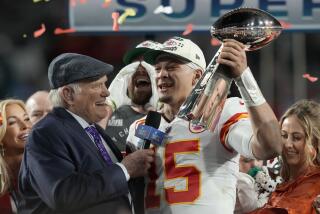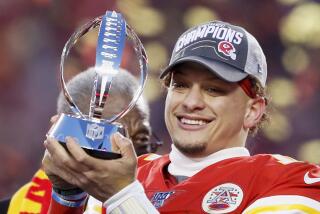Frankie Albert, 82; 1st T-Formation Quarterback
- Share via
Frankie Albert, the first T-formation quarterback in modern football history, died Wednesday of complications from Alzheimer’s disease in a Palo Alto nursing home. He was 82.
Albert, a little left-handed passer with sleight-of-hand deception, was the heart of Stanford’s undefeated 1940 team that climaxed its season with a 21-13 win over Nebraska in the 1941 Rose Bowl game. Against the Cornhuskers, he threw a 40-yard touchdown pass to Hugh Gallarneau, blocked two defenders on a 39-yard punt return for a touchdown by Pete Kmetovic, got off an 85-yard quick kick and kicked three extra points.
“Go tell that [Stanford Coach] Clark Shaughnessy I’ll buy him 120 acres of fine corn if he’ll tell me where we can get a Frankie Albert,” Nebraska Coach Biff Jones said after the game. “That kid had too much pass, too much kick, too much noodle for us.”
In 1940, Albert was a unanimous All-American quarterback as a junior, but was edged out by Tom Harmon of Michigan, a senior, for the Heisman Trophy.
Born Jan. 27, 1920 in Chicago, Albert was a graduate of Glendale High, where he was CIF high school player of the year in 1937. He played only one year of varsity football in high school because he weighed only 130 pounds.
As a sophomore at Stanford, he was a 5-foot-9, 160-pound tailback on a team coached by Claude “Tiny” Thornhill that won only one game while scoring seven touchdowns in nine games. When Shaughnessy was named coach in 1940 he installed the T-formation with Albert at quarterback, Gallarneau and Kmetovic at halfbacks and Norm Standlee at fullback, and the Indians were undefeated Pacific Coast Conference champions.
Shaughnessy later said that if Albert had not succeeded as his quarterback, he might have abandoned the T-formation.
In an article for Esquire in 1943, Shaughnessy wrote of his Stanford team: “First of all, there was Albert, a superb ballhandler, a magician with the ball and a gifted field general; wonderfully observing, a great left-handed passer and a great kicker. He was neither strong nor fast. His talents were primarily those of a faker; he could fool people, and by temperament he ate up that sort of assignment.”
He could play defense too. In a crucial game with USC, which had a 17-game winning streak, Albert returned an intercepted pass for a touchdown in a 21-7 win.
His senior year did not turn out as well. Stanford won six and lost three, climaxed by a 16-0 loss to California. After playing three years, Albert graduated in 1941 and joined the Navy, where he served as an aircraft officer in the Pacific during World War II.
Albert was the first player selected by the San Francisco 49ers of the then-new All-America Conference. He played seven seasons with the 49ers as a T-formation quarterback and one season with Calgary in the Canadian Football League before retiring.
The 49ers hired him as a scout and coach and in 1956 he was elevated to head coach by owner Tony Morabito, a position he held for three years. In 1957 the 49ers tied Detroit for the Western Conference title and led, 27-7, in the third quarter of a playoff game before the Lions rallied to win, 31-27.
After retiring from football, Albert and his wife, Marty, his high school sweetheart who followed him to Stanford, lived in Pebble Beach, Menlo Park and Palm Desert before Albert developed Alzheimer’s and moved to Palo Alto.
Survivors include his wife; three daughters, Nancy James of Bend, Ore., Jane Willens of Palo Alto and Terry Levin of San Francisco; and seven grandchildren.
Services will be private, but a memorial service at Stanford is being planned.
The family has requested that donations be made to Stanford University, 326 Galvez St., Stanford, CA 94305, or Alzheimer’s Assn., 2065 W. El Camino Real, Mountain View, CA 94040.
More to Read
Go beyond the scoreboard
Get the latest on L.A.'s teams in the daily Sports Report newsletter.
You may occasionally receive promotional content from the Los Angeles Times.










